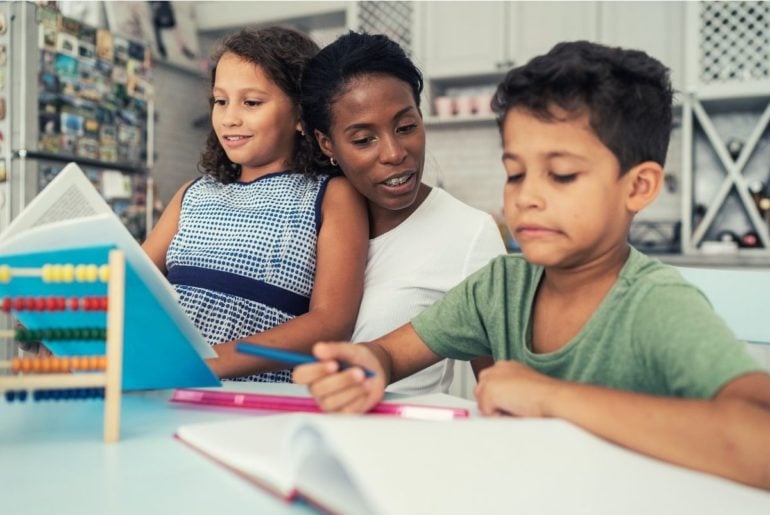Parents have never had a greater need for homeschooling resources and tips, given that millions of students are still remote learning due to the COVID-19 pandemic at least part time. In fact, many families have gone a step further and made the official switch to homeschooling. With vaccination distribution lagging, it’s still uncertain whether schools will reopen for in-person learning as usual next fall. In the meantime, these tips from Richard Peterson, Chief Academic Officer at Kiddie Academy, may help.
Know your child’s limits.
“There are several pitfalls to virtual learning which parents should be aware of while working with their child or children,” Peterson says. “A preschooler should not spend more than 30 minutes a day online learning. The time would increase for kindergarten and first-grade students to 45 minutes. Attempting to spend greater amounts of time online could turn out to be a stumbling block for the child, parent, and teacher.”
In short, kids have limited attention spans, and generally speaking, the older they are, the longer the stretch they can be expected to remain focused. If you notice your child is daydreaming, doodling, or simply not paying attention during long learning sessions, try talking to the teacher or principal about amending their schedule, or consider going the full homeschool route, so you can structure their learning accordingly. Families who chose the latter are better able to work their child’s learning around their work schedules, too.
Commit to a routine.
Even if they’re learning at home, children thrive on routine. It helps them know what comes next, so there are no big surprises throughout their day. Whether your child is logging in to live classes or you’re creating their schedule on your own, commit to a school day routine much like you would if all children were learning in person. “Try to run things similarly to how you would in the office: Create to-do lists for your kids, schedule lunch and breaks, etc.” says Peterson. It’s also a good idea to wake up at the same time every day, get your child “dressed” for school, and make sure they eat breakfast and lunch at the same time every day.
Know how to troubleshoot connectivity issues.
“The success of the course work delivery is dependent upon reliable internet access,” Peterson says. “These classes are contingent upon clear video and audio feeds, and even with a slight hiccup, distraction and learning difficulty are not far off.”
Issues with lackluster or nonexistent WiFi connections have been a huge problem for many students, one that has disproportionately affected students from lower socioeconomic backgrounds as well as those who live in rural areas. About 15 percent of all households with school-age children lack a high-speed internet connection, per the Pew Research Center.
Luckily there are things you can do to help make virtual learning work, even without easy access to the internet. Many parents don’t know that most school districts across the country provide WiFi hotspots for free, and most cell providers include hotspot service with their plans, providing yet another way to boost connectivity by turning you and your kids’ phones into mobile hotspots. Try setting it up as a backup ahead of time; this way, if your primary router goes offline, they’ll only miss a few minutes of their lesson, at most.
Minimize distractions.
Even with a routine in place, the onset of distractions can derail distance learning. “Siblings, television, cell phones, pets … even children who are usually able to complete work and study with slight distractions around, may find it more difficult to resist the temptation to be sidetracked now spending the entire day at home,” Peterson says.
Do what you can to help keep them on track and support their learning; doing things like incorporating physical movement into their days can really help them focus. Scroll through the images below for tips on keeping kids focused and motivated through virtual learning.
Get help when you need it.
Parents helping their kids navigate online learning generally aren’t professional teachers—nor are we expected to be. You already know your child’s teacher is a great resource for help, but according to Peterson, local libraries and early childcare networks can provide free resources as well. Additional examples of additional free online resources include Storyline Online, Tutor.com, Learn to Be, HippoCampus, and SmartTutor.
Additionally, the Center For Public Research and Leadership at Columbia University has put together a comprehensive guide to help parents determine the best educational pathway for their family. The guide includes advice, resources, and tools for families from over 150 families and educators. It outlines step-by-step instructions for setting up learning at home through your child’s school, making school pods work for you, or exploring other options including homeschooling. All of their resources are also available in Spanish.







